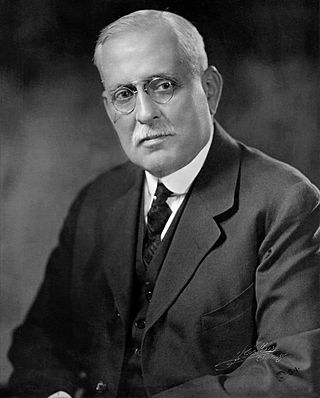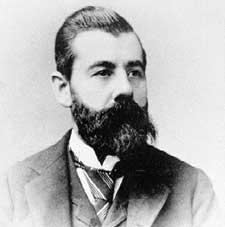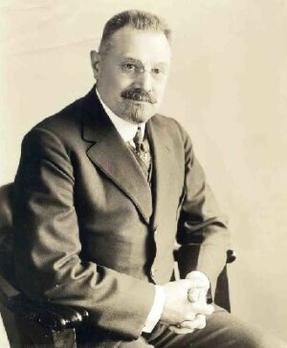
The Edison Machine Works was a manufacturing company set up to produce dynamos, large electric motors, and other components of the electrical illumination system being built in the 1880s by Thomas A. Edison in New York City.

The Edison Machine Works was a manufacturing company set up to produce dynamos, large electric motors, and other components of the electrical illumination system being built in the 1880s by Thomas A. Edison in New York City.
The need for equipment in the development of a large-scale electric illumination "utility" in New York City, starting around 1880, soon outstripped the capacity of Thomas Edison's machine shop at Menlo Park. To alleviate the problem in 1881 Edison leased the old Etna Iron Works at 104 Goerck Street, Lower Manhattan and set up the Edison Machine Works with Edison providing 90% of the capital and investor partner Charles Batchelor providing 10%. [1] [2] The workforce built up to some 800 men supervised by Edison machinist Charles Dean. [3] This shop supplied jumbo dynamos for the original Pearl Street Station as well as dynamos of various sizes for the different types of electric light installations Edison was offering customers. The Machine Works was incorporated in 1884 with Edison investor Charles Batchelor as general manager, John Kruesi as assistant general manager, and Samuel Insull as secretary. [4] At the end of 1885 the Electric Tube Company and the Edison Shafting Manufacturing Company were merged into the Edison Machine Works.
The Machine Works also had a department that designed and tested equipment and trained Edison workers how to wire buildings and install and repair dynamos. New types of dynamos were designed here as well as improved power consumption meters. [3]

The demands of the expanding utility soon overtaxed the cramped lower Manhattan shop. Extra lathes needed for production had to be set up on the sidewalks outside the building connected through the factory windows by long drive belts. [5] Strikes, unionizing attempts, and the general expense of labor and land in New York City sent Edison looking for a site for a new factory. In 1886 the Machine Works, along with 200 of its workers, were moved to two unfinished factory buildings on a 10-acre site in Schenectady, NY, intended to have been the McQueen Locomotive Works. [6] The new factory was put under the control of Samuel Insull. [5] Edison Machine Works continued as a separate company until 1889, when all of Edison's electric related companies were merged to form Edison General Electric. The plant expanded rapidly and 1892 saw the merger of Edison General Electric and the Thomson-Houston Electric Company of Lynn, Massachusetts to form General Electric with the Schenectady location used as GE's headquarters for many years thereafter.


Thomas Alva Edison was an American inventor and businessman. He developed many devices in fields such as electric power generation, mass communication, sound recording, and motion pictures. These inventions, which include the phonograph, the motion picture camera, and early versions of the electric light bulb, have had a widespread impact on the modern industrialized world. He was one of the first inventors to apply the principles of organized science and teamwork to the process of invention, working with many researchers and employees. He established the first industrial research laboratory.
Menlo Park is an unincorporated community within Edison Township in Middlesex County, in the U.S. state of New Jersey.

Samuel Insull was a British American business magnate. He was an innovator and investor based in Chicago who helped create an integrated electrical infrastructure in the United States. Insull created holding companies that purchased utilities and railroads. Insull was responsible for the building of the Chicago Civic Opera House in 1929. Due to the Great Depression, his vast Midwest holding company empire collapsed, and he was accused of profiting personally by selling worthless stock to unsuspecting investors who trusted him because of his position and reputation. Following a seven-week trial, he and 16 co-defendants were acquitted of all charges after two hours of jury deliberation.
Commonwealth Edison, commonly known by syllabic abbreviation as ComEd, is the largest electric utility in Illinois, and the primary electric provider in Chicago and much of Northern Illinois. Its service territory stretches roughly from Iroquois County on the south to the Wisconsin border on the north and from the Iowa border on the west to the Indiana border on the east. For more than 100 years, Commonwealth Edison has been the primary electric delivery services company for Northern Illinois. Today, ComEd is a unit of Chicago-based Exelon Corporation, one of the nation's largest electric and gas utility holding companies. ComEd provides electric service to more than 3.8 million customers across Northern Illinois. The company's revenues totaled more than $7 billion in 2023.

Charles W. Batchelor was an inventor and close associate of American inventor Thomas Alva Edison during much of Edison's career. He was involved in some of the greatest inventions and technological developments in history.

The Thomas Edison Center at Menlo Park, also known as the Menlo Park Museum / Edison Memorial Tower, is a memorial to inventor and businessman Thomas Alva Edison, located in the Menlo Park area of Edison, Middlesex County, New Jersey. The tower was dedicated on February 11, 1938, on what would have been the inventor's 91st birthday.
The Thomson-Houston Electric Company was a manufacturing company that was one of the precursors of General Electric.

The Edison Illuminating Company was established by Thomas Edison on December 17, 1880, to construct electrical generating stations, initially in New York City. The company was the prototype for other local illuminating companies that were established in the United States during the 1880s.

Kunihiko Iwadare was a Japanese businessman. A graduate of the Imperial College of Engineering in Tokyo, he worked as a telegraph engineer for the Japanese government.
Tesla Electric Light and Manufacturing Company was an electric lighting company in Rahway, New Jersey that operated from December 1884 through 1886.
Thomas Edison (1847–1931) was an American inventor and businessman.

Francis Robbins Upton was an American physicist and mathematician. Upton worked alongside Thomas Edison in the development of incandescent light bulbs, electric generators, and electric power distribution. He was the first president of the Edison Pioneers.

John Kruesi was a Swiss-born machinist, and close associate of Thomas Edison.
The Edison Pioneers was an organization composed of former employees of Thomas Edison who had worked with the inventor in his early years. Membership was limited to people who had worked closely with Edison before 1885. On February 11, 1918, the Edison Pioneers met for the first time, on the 71st birthday of Edison. There were 37 people at the first meeting. Edison himself was not present; it was announced he was "engaged in important government service". It was suspected he was working on a military project since World War I was still in progress. The organization had 100 members although in later years descendants of Edison Pioneers were also allowed membership.

Edwin Wilbur Rice Jr. was a president and considered one of the three fathers of General Electric.

Thomas A. Edison, Incorporated was the main holding company for the various manufacturing companies established by the inventor and entrepreneur Thomas Edison. It was a successor to Edison Manufacturing Company and operated between 1911 and 1957, when it merged with McGraw Electric to form McGraw-Edison.

John William Lieb was an American electrical engineer for the Edison Electric Light Company. Lieb was president of the American Institute of Electrical Engineers from 1904 to 1905. He received the IEEE Edison Medal for "the development and operation of electric central stations for illumination and power."

John White Howell was an American electrical engineer who spent his entire professional career working for Thomas Edison, specializing in the development and manufacturing of the incandescent lamp.

René Thury was a Swiss pioneer in electrical engineering. He was known for his work with high voltage direct current electricity transmission and was known in the professional world as the "King of DC."

The Edison State Park is located in the Menlo Park section of Edison, New Jersey. It is located on Christie Street, the first street in the world to be lit up by lightbulb, just off Lincoln Highway, near the Metropark Train Station. It covers a total area of 37 acres (0.15 km2). The park commemorates the site where the famous inventor Thomas Alva Edison had his Menlo Park laboratory. In his laboratory, Edison invented over 600 inventions such as the incandescent electric light and the phonograph, the latter being the first object to record and play sound.